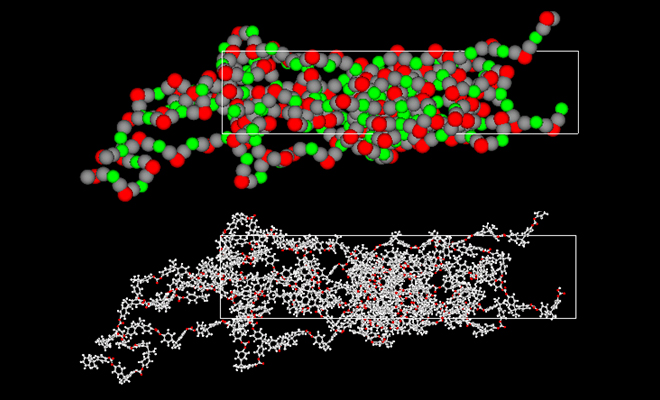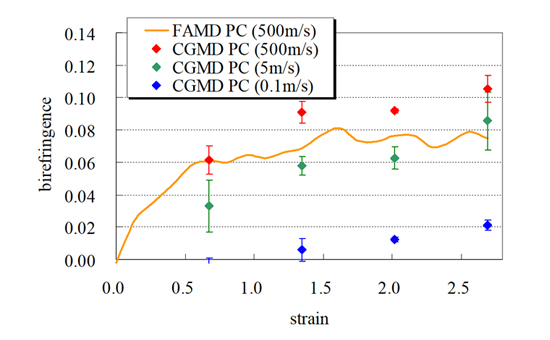Analysis of birefringence using Coarse-Grained Molecular Dynamics
Coarse-Grained Molecular Dynamics (CGMD) combined with reverse mapping was used to analyze the birefringence properties of polymers. The relationship between molecular orientation and optical anisotropy was clarified, demonstrating that this is an effective analysis method for optical material design and evaluation.
Use Cases Highlights
- Birefringence evaluation using Coarse-Grained Molecular Dynamics and reverse mapping techniques
- Analysis at slow deformation rates difficult for Full-Atomistic MD
Evaluation of birefringence using Coarse-Grained Molecular Dynamics and reverse mapping techniques
Snapshots of uniaxial elongation from Coarse-Grained Molecular Dynamics (CGMD) (top) and the corresponding Full-Atomistic structure obtained by reverse mapping (bottom) are shown. Converting Coarse-Grained structures to Full-Atomistic models enables detailed evaluation of optical properties.

(Top) Snapshot of uniaxial elongation calculation using Coarse-Grained Molecular Dynamics (CGMD) (Bottom) Structure reverse-mapped from CGMD results to Full-Atomistic Molecular Dynamics (FAMD)
Analysis at slow deformation rates difficult for Full-Atomistic Molecular Dynamics (FAMD)
Changes in birefringence due to differences in deformation rate are shown. In Full-Atomistic Molecular Dynamics (FAMD), deformation occurs more rapidly and excessive orientation tends to occur, whereas in Coarse-Grained Molecular Dynamics (CGMD) slower deformation is possible, resulting in birefringence values closer to experimental data.

Change in birefringence due to uniaxial elongation (comparison between Full-Atomistic Molecular Dynamics (FAMD) and Coarse-Grained Molecular Dynamics (CGMD))
Reference
[1] https://www.j-octa.com/cases/caseA06/
[2] (In Japanese) J. Polymer Sci. and Tec., 51, pp237-243, (1994)
[2] (In Japanese) J. Polymer Sci. and Tec., 51, pp237-243, (1994)
Details of analysis
Inquiries Regarding Products
Have questions about product implementation? Contact us today.





